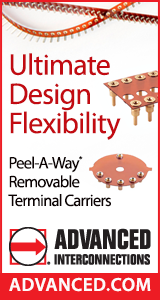|

|
Additive Manufacturing Approach for Integrated, Robust 3D Electronics
Production Floor |
|
Authored By:Rahul Raut and Bawa Singh MacDermid Alpha Electronics Solutions NJ, USA Nirmalya Kumar Chaki, Chetan Pravinchandra Shah, Sathish Kumar, Vasuki Kaushik and Supriya Devarajan MacDermid Alpha Electronics Solutions Bangalore, India SummaryConventional electronics manufacturing and assembly typically involve extensive use of rigid FR4-based PCBs and flexible polyimide-based PCBs. Both rigid and flexible PCBs commonly utilize subtractive and etching processes for PCB fabrication, followed by standard SMT printing and assembly processes. As electronics integration becomes more ubiquitous, emerging manufacturing methods must be sustainable and utilize additive, greener processes. Additionally, there is a growing demand for next-generation 3D electronic shapes and PCBs compared to standard rigid 2D FR-4 PCBs. These next-gen electronics require lightweight, thinner form factors, robustness, and integration. To address these requirements for 3D and integrated electronics, various pathways and platforms are being currently explored. This paper focuses on the In-Mold Electronics (IME) approach, which facilitates the transition from subtractive to additively printed, robust, and 3D electronic structures. The paper delves into the key building blocks of In-Mold Electronics, including flexible hardcoated polymeric substrates, formable conductive silver inks, formable insulating/dielectric inks, and electrically conductive adhesives (ECAs). It also discusses various process considerations and requirements such as screen printing, thermal curing, thermoforming, and injection molding. Finally, the paper addresses some of the thermal and electrical reliability requirements for IME structures and covers the preliminary results of the IME structures. It concludes by demonstrating how IME can be utilized for sustainable and greener high-volume manufacturing, facilitating the fabrication of next-generation 3D electronics to meet emerging requirements. ConclusionsConventional electronics manufacturing relies on subtractive and etching processes for PCB fabrication, followed by surface mount technology (SMT) assembly. As electronics become increasingly ubiquitous, electronics manufacturers must explore sustainable, additive manufacturing platforms. This paper proposes a novel In-Mold Electronics (IME) platform that enables the additive fabrication of 3D integrated and smart electronics. It facilitates the production of next-generation 3D devices through a sustainable and environmentally friendly high-volume manufacturing (HVM) process. The paper presented key electronic materials and processes required for the additive fabrication of integrated IME structures. These materials include functional polymeric substrates, formable silver ink, formable carbon ink, and dielectric ink. Additionally, the paper examined the processing and application aspects, detailing the effects of various screen-printing parameters, jet drying temperatures and times, thermoforming, and injection molding on the electrical properties of IME structures. In summary, In-Mold Electronics represents an interconnected ecosystem of diverse electronic materials and optimal processing conditions. When effectively combined, these elements can enable high volume, additive manufacturing of high-reliability, smart 3D electronic structures and human-machine interfaces. Initially Published in the SMTA Proceedings |
|
Comments
|
|
|
|

|


